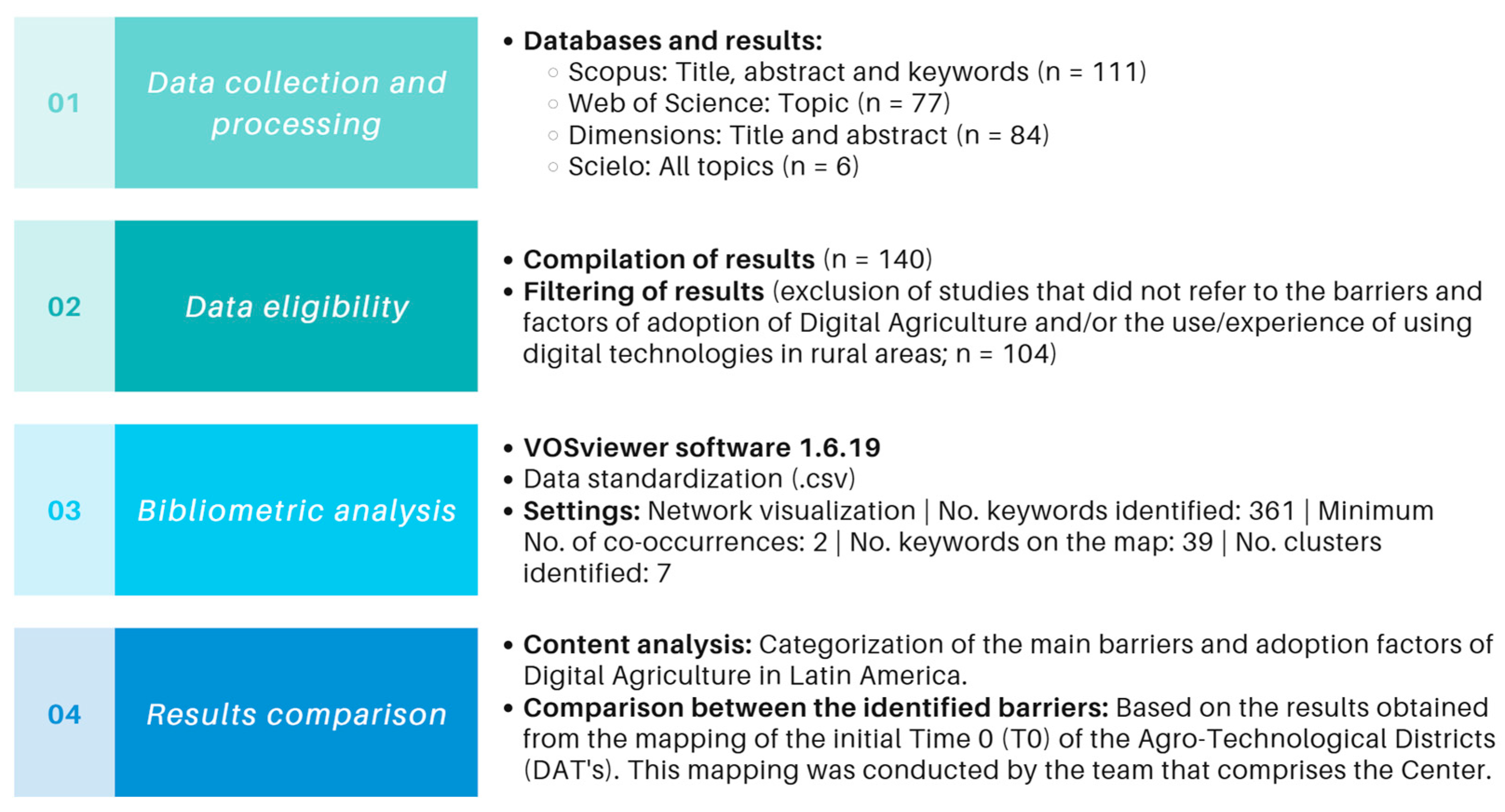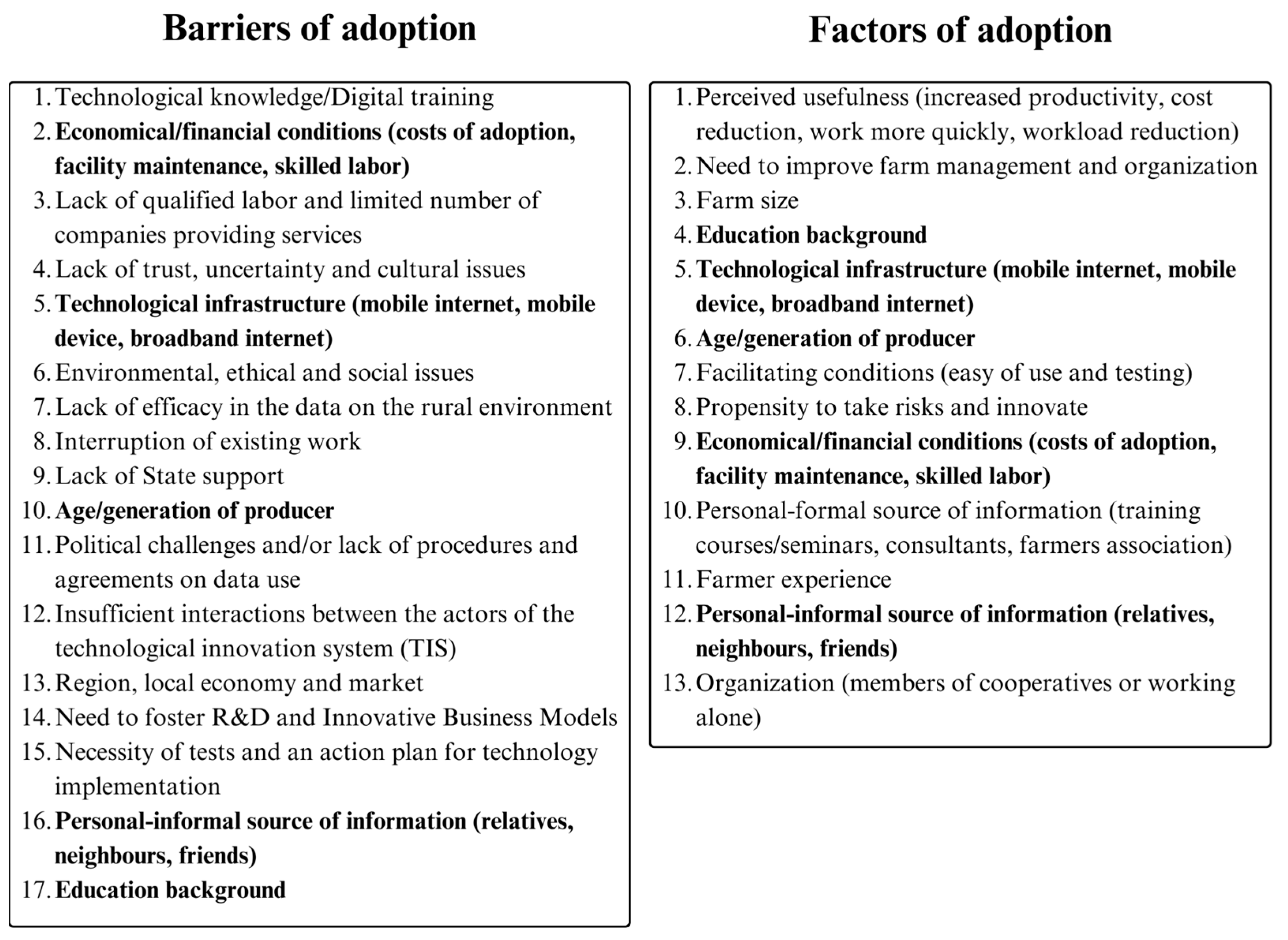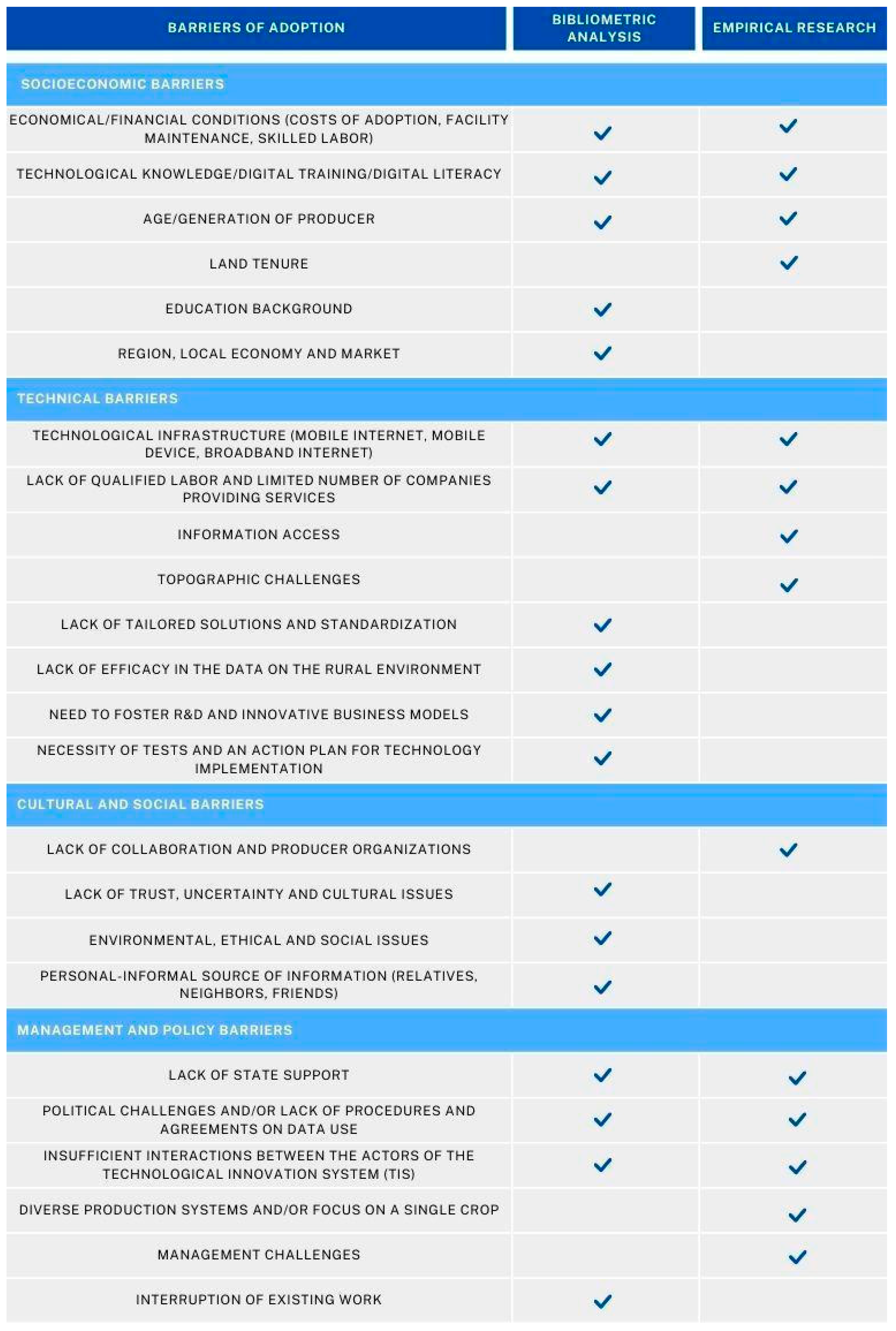Drivers and Barriers to Digital Agriculture Adoption: A Mixed-Methods Analysis of Challenges and Opportunities in Latin American
Abstract
1. Introduction
2. Theoretical Background
3. Materials and Methods
4. Results and Discussion
4.1. Bibliometric Analysis
4.2. Barriers to the Adoption of Digital Technologies in the Context of the Semear Digital Center
- To map and select production chains that require digital solutions in various areas;
- To develop digital solutions through partnerships;
- To identify connectivity bottlenecks and propose communication solutions;
- To research, develop, and validate enabling technologies for digital solutions;
- To train farmers, agricultural technicians, and consultants on digital technologies through farmer associations, cooperatives, and public and private extension offices.
- Land management issues that hinder the implementation of computerized systems, along with a lack of standardized production processes;
- A lack of organization and collaboration among producers, who could share information and technologies;
- An absence of technologies specifically tailored to the needs of rural producers;
- The region’s topography, which may hinder the adoption of certain digital technologies;
- Limited access to information, particularly regarding the existence of such technologies;
- Secure land tenure, essential for accessing rural credit and agricultural development projects; and,
- Diversity in production systems and/or a focus on a single crop, as some crops benefit more from digital technologies than others, making it difficult to adapt these technologies to other crops.
5. Conclusions
- Digital literacy programs: Partner with cooperatives to deliver localized training, addressing age-related barriers.
- Rural connectivity PPPs: Leverage public–private partnerships to expand connectivity.
- Tailored financial instruments: Develop microloans for smallholders, informed by credit constraints.
- Land tenure formalization: Integrate tenure security with digital adoption policies to unlock credit access.
Author Contributions
Funding
Institutional Review Board Statement
Informed Consent Statement
Data Availability Statement
Conflicts of Interest
Appendix A
| DAT | N. Agricultural Establishments | Production Chains | Biome | Barriers to Adopting Digital Technologies |
|---|---|---|---|---|
| Alto Alegre (São Paulo) | 468 | Sugarcane, peanut, banana, corn, watermelon, rubber, and coffee | Atlantic Forest | Connectivity and infrastructure constraints: Limited rural connectivity, and inadequate infrastructure, including electricity and mobile internet. Digital literacy: Low digital literacy among producers. Cost barriers: High equipment and software costs, along with internet connection fees. Lack of collaboration and producer organizations: A demand exists for platforms to share information, negotiate collectively, and access technologies. Management challenges: Producers face difficulties in tracking production costs and income. |
| Boa Vista do Tupim (Bahia) | 2.536 | Cassava, tomato, watermelon, corn, beans, and goats | Caatinga | Connectivity and infrastructure constraints: Limited rural connectivity, and inadequate infrastructure, including electricity and cellular networks. Digital literacy: Digital literacy is a critical need for farmers. Lack of collaboration and producer organizations: Producers seek platforms for knowledge sharing, collective bargaining, and technology access. |
| Caconde (São Paulo) | 1.262 | Coffee and fish farming (tilapia) | Atlantic Forest | Connectivity and infrastructure constraints: Despite high digital technology adoption for weather forecasting and planning, limited rural connectivity hinders the full potential of digital agriculture. Digital literacy: Farmers require more training in production, management, and marketing to effectively use digital tools. Cost barriers: High costs and complexity limit farmers’ access to advanced technologies. Industry investment: Insufficient industry investment in digital agriculture solutions. |
| Guia Lopes da Laguna (Mato Grosso do Sul) | 672 | Soybean, corn, crop-livestock-forest integration, cassava, sugarcane, coconut, tomato, banana, watermelon, sweet potato, and beekeeping | Cerrado | Connectivity and infrastructure constraints: Limited fiber optic infrastructure in rural areas restricts access to high-quality internet. Cost barriers: High deployment costs limit internet service providers’ investments in rural areas. Digital literacy: Low digital literacy among small-scale producers. Information access: Limited internet access restricts access to digital resources and tools for farm management. Lack of tailored solutions and standardization: Existing digital solutions often do not meet the specific needs of small-scale farmers. |
| Ingaí (Minas Gerais) | 236 | Dairy cattle farming, corn, and soybean | Atlantic Forest | Digital literacy: Low digital literacy among producers. Age and generational gap: The age of producers is a significant challenge to digital agriculture adoption. Skills gap/lack of skilled labor: Producers require specific training to use digital tools and there is a demand for skilled labor. Credit constraints: Limited access to credit hinders technology investments. |
| Jacupiranga (São Paulo) | 505 | Banana, heart of palm, cassava, corn, rubber, passion fruit, rice, coconut, sugarcane, guava, and buffalo | Atlantic Forest | Connectivity and infrastructure constraints: While internet coverage is adequate, digital adoption is primarily focused on drone-based spraying, with untapped potential in other areas. Limited roads and electricity restrict technology adoption. Digital literacy: Low digital literacy, especially for invoicing and app usage. Skills gap/lack of skilled labor: Producers require training in crop management, drone operations, and management software. Management challenges: Lack of a centralized database hinders data-driven decision-making. Land tenure: Secure land tenure is essential for accessing credit and development projects. Cost barriers: High production costs and limited credit hinder technology investments. Topographic challenges: Rugged terrain limits technology adoption in certain areas. |
| Lagoinha (São Paulo) | 257 | Corn, dairy cattle farming, cassava, tangerine, tomato, beans, pigs, and laying hens | Atlantic Forest | Connectivity and infrastructure constraints: Uneven fiber optic coverage creates a digital divide. Limited data infrastructure hinders the implementation of advanced digital solutions. Cost barriers: High equipment costs and internet fees limit technology adoption. Digital literacy: Low digital literacy among producers, especially older ones. Skills gap/lack of skilled labor: Producers require training in various areas to effectively use digital tools. Credit constraints: Limited access to credit hinders technology investments. Diverse production systems: The diversity of agricultural activities requires tailored technological solutions. Lack of tailored solutions and standardization: Varied production practices and products hinder large-scale technology implementation. |
| São Miguel Arcanjo (São Paulo) | 1.916 | Fruit and vegetable cultivation | Atlantic Forest | Connectivity and infrastructure constraints: Uneven internet coverage limits digital access. Lack of infrastructure limits agricultural development and technology use. Digital literacy: Low digital literacy among producers is a major barrier. Cost barriers: High costs of technology hinder adoption. Bureaucratic hurdles and policy gaps: Complex regulations hinder production and marketing. Insufficient government support discourages technology adoption. Lack of collaboration and producer organizations: Individualism limits negotiation and resource access. Credit constraints: Limited access to credit hinders investments. |
| Vacaria (Rio Grande do Sul) | 1.039 | Apple, grape, blackberry, blueberry, soybean, corn, wheat, potato, oats, barley, beans, onion, tomato, pear, peach, orange, tangerine, cassava, persimmon, and sweet potato | Atlantic Forest | Connectivity and infrastructure constraints: Limited connectivity hinders digital tool access and data collection. Focus on a single crop: The apple chain is a leading adopter of digital technologies, but other crops lag. Digital literacy: Low digital literacy among small-scale producers. Skills gap/lack of skilled labor: Producers require training in various areas to effectively use digital tools. Cost barriers: High equipment costs and internet fees limit technology adoption. |
References
- Massruhá, S.M.F.S.; Leite, M.A.A.; Luchiari, A., Jr.; Evangelista, S.R.M. Digital transformation in the field towards sustainable and smart agriculture. In Digital Agriculture: Research, Development and Innovation in Production Chains; Massruhá, S.M.F.S., Leite, M.A.A., Oliveira, S.R.M., Meira, C.A.A., Luchiari, A., Jr., Bolfe, E.L., Eds.; Embrapa: Brasília, Brazil, 2023; pp. 17–35. [Google Scholar]
- Da Silveira, F.D.; Silva, S.L.C.D.; Machado, F.M.; Barbedo, J.G.A.; Amaral, F.G. Agriculture 4.0 and its Barriers in the Agricultural Production Chain Development in Southern Brazil. SSRN 2022, 4229367. [Google Scholar] [CrossRef]
- Dibbern, T.; Romani, L.A.S.; Massruhá, S.M.F.S. Main drivers and barriers to the adoption of Digital Agriculture technologies. Smart Agric. Technol. 2024, 8, 100459. [Google Scholar] [CrossRef]
- Pauschinger, D.; Klauser, F.R. The introduction of digital technologies into agriculture: Space, materiality and the public–private interacting forms of authority and expertise. J. Rural. Stud. 2022, 91, 217–227. [Google Scholar] [CrossRef]
- Gebresenbet, G.; Bosona, T.; Patterson, D.; Persson, H.; Fischer, B.; Mandaluniz, N.; Chirici, G.; Zacepins, A.; Komasilovs, V.; Pitulac, T.; et al. A concept for application of integrated digital technologies to enhance future smart agricultural systems. Smart Agric. Technol. 2023, 5, 100255. [Google Scholar] [CrossRef]
- Soma, T.; Nuckchady, B. Communicating the benefits and risks of digital agriculture technologies: Perspectives on the future of digital agricultural education and training. Front. Commun. 2021, 6, 762201. [Google Scholar] [CrossRef]
- ITU; FAO. Status of Digital Agriculture in 18 Countries of Europe and Central Asia; ITU: Geneva, Switzerland, 2020. [Google Scholar]
- Lasi, H.; Fettke, P.; Kemper, H.G.; Feld, T.; Hoffmann, M. Industry 4.0. Bus. Inf. Syst. Eng. 2014, 6, 239–242. [Google Scholar] [CrossRef]
- De Souza, K.X.S.; Oliveira, S.R.M.; Macário, C.G.N.; Esquerdo, J.C.D.M.; Moura, M.F.; Leite, M.A.A.; de Lima, H.P.; de Castro, A.; Ternes, S.; Yano, I.H.; et al. Digital agriculture: Definitions and technologies. In Digital Agriculture: Research, Development and Innovation in Production Chains; Massruhá, S.M.F.S., Leite, M.A.A., Oliveira, S.R.M., Meira, C.A.A., Luchiari, A., Jr., Bolfe, E.L., Eds.; Embrapa: Brasília, Brazil, 2023; pp. 37–50. [Google Scholar]
- Massruhá, S.M.F.S.; Leite, M.A.A. Agricultura digital. Rev. Eletrônica Competências Digit. Agric. Fam. 2016, 2, 72–88. [Google Scholar]
- Shepherd, M.; Turner, J.A.; Small, B.; Wheeler, D. Priorities for science to overcome hurdles thwarting the full promise of the ‘digital agriculture’ revolution. J. Sci. Food Agric. 2020, 100, 5083–5092. [Google Scholar] [CrossRef]
- Bolfe, E.L.; Massruhá, S.M.F.S. A transformação digital e a sustentabilidade agrícola. Agroanalysis 2020, 40, 32–34. [Google Scholar]
- Bolfe, E.L.; Jorge, L.A.D.C.; Sanches, I.D.A.; Luchiari, A., Jr.; da Costa, C.C.; Victoria, D.D.C.; Inamasu, R.Y.; Grego, C.R.; Ferreira, V.R.; Ramirez, A.R. Precision and digital agriculture: Adoption of technologies and perception of Brazilian farmers. Agriculture 2020, 10, 653. [Google Scholar] [CrossRef]
- Schroeder, K.; Lampietti, J.; Elabed, G. What’s Cooking: Digital Transformation of the Agrifood System; Agriculture and Food Series; World Bank: Washington, DC, USA, 2021. [Google Scholar] [CrossRef]
- Caffaro, F.; Cavallo, E. Perceived Barriers to the Adoption of Smart Farming Technologies in Piedmont Region, Northwestern Italy: The Role of User and Farm Variables. In Innovative Biosystems Engineering for Sustainable Agriculture, Forestry and Food Production: International Mid-Term Conference 2019 of the Italian Association of Agricultural Engineering (AIIA); Springer International Publishing: Berlin/Heidelberg, Germany, 2020; pp. 681–689. [Google Scholar]
- Caffaro, F.; Cremasco, M.M.; Roccato, M.; Cavallo, E. Drivers of farmers’ intention to adopt technological innovations in Italy: The role of information sources, perceived usefulness, and perceived ease of use. J. Rural. Stud. 2020, 76, 264–271. [Google Scholar] [CrossRef]
- Da Silveira, F.; Barbedo, J.G.A.; da Silva, S.L.C.; Amaral, F.G. Proposal for a framework to manage the barriers that hinder the development of agriculture 4.0 in the agricultural production chain. Comput. Electron. Agric. 2023, 214, 108281. [Google Scholar] [CrossRef]
- Van Eck, N.J.; Waltman, L. Visualizing bibliometric networks. In Measuring Scholarly Impact: Methods and Practice; Ding, Y., Rousseau, R., Wolfram, D., Eds.; Springer International Publishing: New York, NY, USA, 2014; pp. 285–320. [Google Scholar] [CrossRef]
- Waltman, L.; Van Eck, N.J.; Noyons, E.C. A unified approach to mapping and clustering of bibliometric networks. J. Informetr. 2010, 4, 629–635. [Google Scholar] [CrossRef]
- Acosta, M.; Riley, S.; Bonilla-Findji, O.; Martínez-Barón, D.; Howland, F.; Huyer, S.; Castellanos, A.; Martínez, J.; Chanana, N. Exploring women’s differentiated access to climate-smart agricultural interventions in selected climate-smart villages of Latin America. Sustainability 2021, 13, 10951. [Google Scholar] [CrossRef]
- Mosso, C.; Pons, D.; Beza-Beza, C. A Long Way toward Climate Smart Agriculture: The Importance of Addressing Gender Inequity in the Agricultural Sector of Guatemala. Land 2022, 11, 1268. [Google Scholar] [CrossRef]
- Engås, K.G.; Raja, J.Z.; Neufang, I.F. Decoding technological frames: An exploratory study of access to and meaningful engagement with digital technologies in agriculture. Technol. Forecast. Soc. Chang. 2023, 190, 122405. [Google Scholar] [CrossRef]
- Florez, M.; Melo, J.; Bourdon, I.; Piot-Lepetit, I.; Gauche, K. Digital Divide between Colombian and French Agriculture. In Proceedings of the 27th Americas Conference on Information Systems (AMCIS 2021), Online Conference, 9–13 August 2021. [Google Scholar]
- Chacho, P.; Maza, J.; Icaza, D.; Arias, P.; Diaz, J.; Amón, X.; Sumba, N.; Pallmay, C.; Coyago, C.; Rivera, P. Wireless system for the control and real time monitoring of agricultural areas of Arenillas canton in Ecuador. In Proceedings of the 2019 IEEE CHILEAN Conference on Electrical, Electronics Engineering, Information and Communication Technologies (CHILECON), Valparaiso, Chile, 13–27 November 2019; IEEE: Piscataway, NJ, USA, 2019; pp. 1–8. [Google Scholar]
- Collado, E.; Fossatti, A.; Saez, Y. Smart farming: A potential solution towards a modern and sustainable agriculture in Panama. AIMS Agric. Food 2018, 4, 266–284. [Google Scholar] [CrossRef]
- Ahmed, M.A.; Gallardo, J.L.; Zuniga, M.D.; Pedraza, M.A.; Carvajal, G.; Jara, N.; Carvajal, R. LoRa based IoT platform for remote monitoring of large-scale agriculture farms in Chile. Sensors 2022, 22, 2824. [Google Scholar] [CrossRef]
- Ramírez, E.A.C.; Albarrán, J.C.; Mora, L.E.M.; Hernández, M.Y. Agro 4.0:¿ Una posibilidad de mejora en el campo venezolano o una solución para la agricultura en Venezuela? Rev. Agroaliment. 2022, 28, 213–229. [Google Scholar] [CrossRef]
- Fernandes, A.D.N.M.; Barros, M.A.D.C.; Hamatsu, N.K. Trend of Technologies 4.0 in Brazil-what does the demand about the Public Selection MCTI/FINEP/FNDCT Grant to Innovation 04/2020 tell us? Rev. Cienc. Agron. 2021, 51, 1–12. [Google Scholar] [CrossRef]
- Pivoto, D.; Barham, B.; Waquil, P.D.; Foguesatto, C.R.; Corte, V.F.D.; Zhang, D.; Talamini, E. Factors influencing the adoption of smart farming by Brazilian grain farmers. Int. Food Agribus. Manag. Rev. 2019, 22, 571–588. [Google Scholar] [CrossRef]
- De Macedo, M.M.G.; Mattos, A.B.; Oliveira, D.A.B. Generalization of convolutional LSTM models for crop area estimation. IEEE J. Sel. Top. Appl. Earth Obs. Remote Sens. 2020, 13, 1134–1142. [Google Scholar] [CrossRef]
- Smith, H.W.; Ashworth, A.J.; Nalley, L.L.; Schmidt, A.; Turmel, M.S.; Bucaro, A.; Owens, P.R. Boundary line analysis and machine learning models to identify critical soil values for major crops in Guatemala. Agron. J. 2023, 116, 1071–1087. [Google Scholar] [CrossRef]
- Carrer, M.J.; de Souza Filho, H.M.; Vinholis, M.D.M.B.; Mozambani, C.I. Precision agriculture adoption and technical efficiency: An analysis of sugarcane farms in Brazil. Technol. Forecast. Soc. Chang. 2022, 177, 121510. [Google Scholar] [CrossRef]
- Puntel, L.A.; Bolfe, E.L.; Melchiori, R.J.M.; Ortega, R.; Tiscornia, G.; Roel, A.; Scaramuzza, F.; Best, S.; Berger, A.G.; Hansel, D.S.S.; et al. How digital is agriculture in a subset of countries from South America? Adoption and limitations. Crop. Pasture Sci. 2022, 74, 555–572. [Google Scholar] [CrossRef]
- Boisier, G.; Hahn, K.; Geldes, C.; Klerkx, L. Unpacking the Precision Technologies for Adaptation of the Chilean Dairy Sector. A Structural-functional Innovation System Analysis. J. Technol. Manag. Innov. 2021, 16, 56–66. [Google Scholar] [CrossRef]
- Kolling, C.E.; Rampim, L. Agricultura de precisão e digital: Perspectivas e desafios dos produtores rurais do estado do paraná. Uningá Rev. 2021, 36, eUJR3981. [Google Scholar] [CrossRef]
- Da Silveira, F.; da Silva, S.L.C.; Machado, F.M.; Barbedo, J.G.A.; Amaral, F.G. Farmers’ perception of barriers that difficult the implementation of agriculture 4.0. Agric. Syst. 2023, 208, 103656. [Google Scholar] [CrossRef]
- Flores, J.A.E.; Montes-Rivera, F.Y.; Valdivia-Alcalá, R.; Cruz-Betanzos, A. Agriculture 4.0: Is Mexico Ready? Agro Prod. 2023, 4, 91–106. [Google Scholar] [CrossRef]
- Mendes, V.; Viola, E. Green Digitalization? Agriculture 4.0 and the Challenges of Environmental Governance in Brazil. In Sustainability Challenges of Brazilian Agriculture: Governance, Inclusion, and Innovation; Springer International Publishing: Cham, Switzerland, 2023; pp. 207–226. [Google Scholar]
- De Souza Filho, H.M.; Buainain, A.M.; da Silveira, J.M.F.J.; Vinholis, M.D.M.B. Condicionantes da adoção de inovações tecnológicas na agricultura. Cad. Ciênc. Tecnol. 2011, 28, 223–255. [Google Scholar]
- Strong, R.; Wynn, J.T.; Lindner, J.R.; Palmer, K. Evaluating Brazilian agriculturalists’ IoT smart agriculture adoption barriers: Understanding stakeholder salience prior to launching an innovation. Sensors 2022, 22, 6833. [Google Scholar] [CrossRef] [PubMed]






Disclaimer/Publisher’s Note: The statements, opinions and data contained in all publications are solely those of the individual author(s) and contributor(s) and not of MDPI and/or the editor(s). MDPI and/or the editor(s) disclaim responsibility for any injury to people or property resulting from any ideas, methods, instructions or products referred to in the content. |
© 2025 by the authors. Licensee MDPI, Basel, Switzerland. This article is an open access article distributed under the terms and conditions of the Creative Commons Attribution (CC BY) license (https://creativecommons.org/licenses/by/4.0/).
Share and Cite
Dibbern, T.; Romani, L.; Massruhá, S. Drivers and Barriers to Digital Agriculture Adoption: A Mixed-Methods Analysis of Challenges and Opportunities in Latin American. Sustainability 2025, 17, 3676. https://doi.org/10.3390/su17083676
Dibbern T, Romani L, Massruhá S. Drivers and Barriers to Digital Agriculture Adoption: A Mixed-Methods Analysis of Challenges and Opportunities in Latin American. Sustainability. 2025; 17(8):3676. https://doi.org/10.3390/su17083676
Chicago/Turabian StyleDibbern, Thais, Luciana Romani, and Silvia Massruhá. 2025. "Drivers and Barriers to Digital Agriculture Adoption: A Mixed-Methods Analysis of Challenges and Opportunities in Latin American" Sustainability 17, no. 8: 3676. https://doi.org/10.3390/su17083676
APA StyleDibbern, T., Romani, L., & Massruhá, S. (2025). Drivers and Barriers to Digital Agriculture Adoption: A Mixed-Methods Analysis of Challenges and Opportunities in Latin American. Sustainability, 17(8), 3676. https://doi.org/10.3390/su17083676






